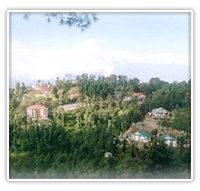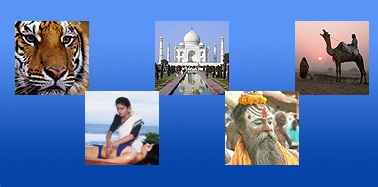|
|
|
|
|
|
|
Home » Hill
Stations in India » Hill Stations in Himachal Pradesh »
Chamba
|
|
|
|
Chamba
|
|
|
|
 The town of Chamba, the district headquarter of Chamba district is situated in the western Himalayas between north latitudes 32°10' and 33°13' and east longitudes 75°45' and 77°33'. The town stands on a plateau on the right bank of the Ravi river valley between Dhauladhar and Zanskar ranges south of the inner Himalayas. This town was founded by Raja Sahil Varman when he conquered the lower Rani valley from the petty chiefs called Ranas and Thakurs in the beginning of 10th Century. It seems the original name of the town was Champa as mentioned in Kalhan's Rajtarangani. In the bansauli or genealogical rolls of the Chamba Rajas a reference occurs of place which was adorned with highly fragrant Champaka trees and guarded by Goddess Champavati or more popularly known as Chameshni. The temple was built by Sahil Varman in the honour of his daughter Champavati who is worshipped as a goddess in Chamba. Champavati temple became the family temple of the ruling family. The town of Chamba, the district headquarter of Chamba district is situated in the western Himalayas between north latitudes 32°10' and 33°13' and east longitudes 75°45' and 77°33'. The town stands on a plateau on the right bank of the Ravi river valley between Dhauladhar and Zanskar ranges south of the inner Himalayas. This town was founded by Raja Sahil Varman when he conquered the lower Rani valley from the petty chiefs called Ranas and Thakurs in the beginning of 10th Century. It seems the original name of the town was Champa as mentioned in Kalhan's Rajtarangani. In the bansauli or genealogical rolls of the Chamba Rajas a reference occurs of place which was adorned with highly fragrant Champaka trees and guarded by Goddess Champavati or more popularly known as Chameshni. The temple was built by Sahil Varman in the honour of his daughter Champavati who is worshipped as a goddess in Chamba. Champavati temple became the family temple of the ruling family.
PLACES OF INTEREST
Chamba has a number of temples, Palaces and stylised
buildings. The striking objects of interest are the old
temples which exhibit architectural beauty of design and
execution.
LAXMI NARAYAN TEMPLE: Laxmi Narayana Temple, which is
the main temple of Chamba town was built by Sahil Varman in
the 10th century AD. The temple has been built in the
Shikhara style. The temple consists of Bimana i.e. Shikhara
and GarbhGriha with a small antralya. Laxmi Narayana Temple
has a mandapa like structure also. The wooden Chhattries,
the shell roof, atop the temple were in response to the
local climatic conditions as a protection against snowfall.
CHAMPAVATI TEMPLE: This temple is located behind the
City Police Post and Treasury building. As mentioned earlier
the temple was built by Raja Sahil Varman in memory of his
daughter Champavati who is believed to have influenced her
father to set-up Chamba at its present location. The temple
is in the Shikhara style with elaborate stone carving and
the wheel roof. The size of this temple is equivalent to the
largest of the Laxmi Narayana Temple.
VAJRESHWARI TEMPLE: This ancient temple is believed
to be 1000 years old and is dedicated to Devi Vajreshwari-Goddess
of lightning. The temple is situated on the northern most
corner of the town at the end of Jansali Bazar. No
historical record of the temple is available. The temple is
built in the Shikhara style with wooden Chhattries and
stands on the platform. The Shikhara of the temple is
elaborately carved. There are two other minor temples on
either side of the main shrine.
 SUI
MATA TEMPLE: This temple can be divided into three parts
which can physically spread apart. The temple of Sui Mata is
on an elevation of Shah Madar Hill. A steep flight of steps
comes down to a small pavilion just above the Saho road.
From the Saho road the flight of steps continues down to the
main town a little to the east of Chauntra Mohalla. At the
end of the flight of steps there is another small pavilion
with gargoyles with running water. The flight of stone steps
to the aqueduct from the Sarota stream was built by Sarda,
the Rani of Raja Jeet Singh (1794-1808). According to the
legend when Raja Sahil Varman founded the town and made this
aqueduct for water supply to the town the water refused to
flow. It was ascribed to supernatural causes. It was
prophasised that the spirit of the stream must be
propitiated, and the Brahmins, on being consulted replied
that the victim must either be the Rani or her son. Another
tradition runs that the Raja himself had a dream in which he
was directed to offer up his son, where upon the Rani
pleaded to be accepted as a substitute. Thus on a appointed
day the Rani along with her maidens was buried alive in a
grave. The legend goes on to say that when the grave was
filled in the water began to flow. SUI
MATA TEMPLE: This temple can be divided into three parts
which can physically spread apart. The temple of Sui Mata is
on an elevation of Shah Madar Hill. A steep flight of steps
comes down to a small pavilion just above the Saho road.
From the Saho road the flight of steps continues down to the
main town a little to the east of Chauntra Mohalla. At the
end of the flight of steps there is another small pavilion
with gargoyles with running water. The flight of stone steps
to the aqueduct from the Sarota stream was built by Sarda,
the Rani of Raja Jeet Singh (1794-1808). According to the
legend when Raja Sahil Varman founded the town and made this
aqueduct for water supply to the town the water refused to
flow. It was ascribed to supernatural causes. It was
prophasised that the spirit of the stream must be
propitiated, and the Brahmins, on being consulted replied
that the victim must either be the Rani or her son. Another
tradition runs that the Raja himself had a dream in which he
was directed to offer up his son, where upon the Rani
pleaded to be accepted as a substitute. Thus on a appointed
day the Rani along with her maidens was buried alive in a
grave. The legend goes on to say that when the grave was
filled in the water began to flow.
CHAMUNDA DEVI TEMPLE: This temple is located on the
spur of the Shah Madar Hill overlooking the town to its
south east. The temple stands on a raised platform. The
temple has artistic carvings on its lintel, pillars and the
ceiling. Behind the main temple is a small shrine of Lord
Shiva in the Shikhara style. There is another platform in
front of this temple where two very old peepul trees provide
shelter to the visitors. From this platform a bird's eye
view of most of the land marks in the town including Chaugan,
Circuit House, most of the temples and river Ravi can be
had. The temple is being looked after by Archaeological
Survey of India.
HARI RAI TEMPLE: This temple is dedicated to Lord
Vishnu and dates back to 11th century. It was probably built
by Salabahana. This temple lies in the north-west corner of
the main Chaugan, which had became the official entrance to
the town by the end of 19th C. A steep path leads to the old
Shitla bridge, which was constructed in the year 1894. The
temple is built in Shikhara style and stands on a stone
platform. The Shikhara of the temple is finely carved. This
is one of the major old temples, which is away from the old
township and the only one near the Chaugan.
CHAUGAN: The Chaugan is the heart and hub centre of
all activities in Chamba. Tradition is silent as to its use
as a polo ground and the name is etymologically distinct
from Chaugan, the Persian name of Polo, being of Sanskrit
origin and meaning 'four-sided'. Initially the five Chaugan
were a single patch of meadow. In 1890s the leveling of the
Chaugan was done. It became a public promenade and Cricket
ground for the British. Annual Minjar Mela is held in the
Chaugan. Local people can be seen promenading in the Chaugan
till late night. Gaddies with their deras can also be seen
camping on the outskirts of this beautiful public promenade.
Because of great pressure on Chaugan the quality of its turf
is fast deteriorating. Chaugan is closed for public after
Dusshera till April for maintenance.
AKHAND CHANDI PALACE: Construction of this
residential building of the Chamba family was started by
Raja Umed Singh sometimes between 1748-1764 AD. The place
was rebuilt and renovated during the reign of Raja Sham
Singh with the help of British engineers. The Darbar Hall
(Marshal Hall) was built in 1879 by Capt. Marshal and the
Zanana Mehal was added in the reign of Raja Bhuri Singh. The
subsequent additions and alterations clearly betray the
Mughal and the British influence. In 1958 the Palace
building was sold by the descendants of the royal family to
the Himachal Government. The latter handed it over to the
Education Department for the purpose of starting a
Government College and District Library. The beautiful
structure of the palace with its painted walls and glass
work, ceiling, intricate woodwork are fast deteriorating,
since sufficient funds are not available for the maintenance
of this monument. The palace has a commanding view of the
Chaugan, Laxmi Narayana Temple, Sui Mata, Chamunda Devi
Temple, Rang Mehal, Hari Rai Temple and Bansi Gopal Temple.
|
|
|
|
|
|
| |
|
|
|
|


